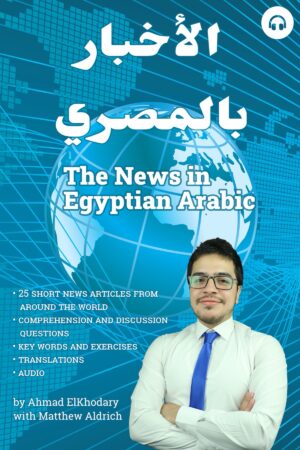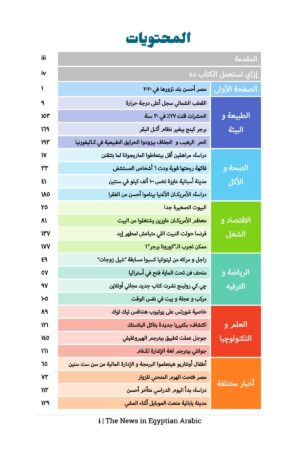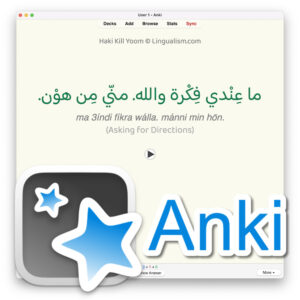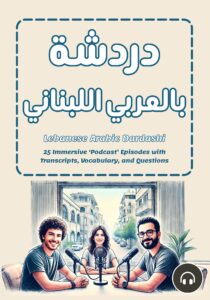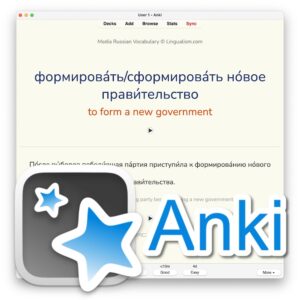Table of Contents
Introduction
In Egypt, as in other Arab countries, the news is published in Modern Standard Arabic (MSA). Of course, people don’t discuss the news in MSA; we use Egyptian Arabic (Masri). And this is the guiding idea behind The News in Egyptian Arabic.
Matthew and I have created this book to help bridge the gap for intermediate and advanced learners who would like to understand and discuss a variety of more advanced topics that take you beyond everyday vocabulary in Egyptian Arabic.
This is also an attempt to demonstrate that Egyptian Arabic is more than just a “colloquial dialect” and that it is actually very practical for students of Arabic to learn even if their learning goals are more academic or formal.
The articles in this book were taken from real news stories in 2020 but were carefully chosen so that the topics would not quickly become dated and would be interesting and relevant for years to come. The units are organized to make them ideal study materials both for independent learners and those studying with a teacher, whether as online private lessons or in a classroom setting.
We hope you enjoy studying from this book as much as we enjoyed creating it, and we will be waiting for your valuable and constructive feedback.
–Ahmad ElKhodary
How to Use the Book
The book is made up of twenty-five units: a front-page article followed by twenty-four more articles grouped into six categories, as can be seen in the Table of Contents.
The Main Text
Each unit begins with its article laid out in a format mimicking a newspaper. As this version of the text does not contain diacritics (tashkeel), it presents a challenge and is the best place to start and end your study of a unit. Before you move on to the other sections of the unit, try reading the main text to see how much you understand and how well you can read the text aloud without the help of diacritics. Then read along while listening to the audio (see page v for the link to the free audio files). After you have studied the article in more depth by completing the other sections of the unit, return to the main text and read it again. From time to time, as a review, you should return to previously studied units and read the main texts again.
Key Words
Several important words from the article are listed in the right-hand column. Irregular plurals of nouns and adjectives, as well as the imperfect form of verbs, are shown in parentheses. Each key word is followed by its definition in Arabic to help you work out the meaning of words that are new to you. Listen to the audio track for key words. If you feel the definitions are too challenging for your level, you can ignore them. After you have studied the key words, match them to their English translations that follow. You can easily match definitions for words you already know and then try to deduce the meaning of other key words by process of elimination and other clues. You can find the answers in the Answer Key at the end of the unit. In the definitions, you may see the following terms:
- إسْم مفْعول (passive participle)
- المبْني لِلمجْهول (passive form [of a verb])
- عكْس (the opposite [of])
The Article
This section presents a version of the article augmented with tools to help you read and understand it better. The article is divided into numbered lines so you can match lines to their phonemic transcriptions and translations in the Answer Key. The text contains diacritics using the Lingualism system of orthography, which you can read more about on our website. In Egyptian Arabic, ق is normally pronounced as a glottal stop (hamza). In some words, especially more academic (or formal) vocabulary, it is pronounced q. To help you with accurate pronunciation, in this book, we place a subtle wavy line under ق when it is pronounced q. Additionally, foreign names (of people, companies, cities, and regions¬–but not countries) appear bold to help you avoid confusion thinking they are Arabic words.
Comprehension and Discussion Questions
Following the article are three comprehension questions. You can find the answers by referring back to the article if needed. Five discussion questions provide ideas for discussion about the topic. If you are studying on your own, you are encouraged to answer them aloud or write your answers. English translations of the questions can be found in the Answer Key.
Expressions and Structures
This multiple-choice exercise helps you notice (and develop skills for noticing) how words work together in context and chunks of useful language. The English translations of four expressions or structures from the article are each followed by four choices in Arabic. One is correct, and three are either grammatically incorrect or do not match the translation. Take your time analyzing and comparing the choices before checking your answers in the Answer Key or searching for the answer in the article.
Answer Key and Translations
The Answer Key provides the answers to the Key Word matching exercise and the Expressions and Structures multiple-choice exercise. You can also find English translations of the article and the comprehension and discussion questions. {Curly brackets} show literal translations, while [square brackets] are necessary in English but are not present in the Arabic. There is also a version of the article in phonemic transcription to assist those who are not yet fully proficient in reading Arabic script for Egyptian Arabic and for those who want to analyze the pronunciation more closely. You can learn more about our phonemic transcription system on our website. Note that, in this book, you will see some vowels in parentheses in the phonemic transcription. These vowels would normally elide (disappear) in fast, relaxed speech; however, because Ahmad is speaking in the audio at a very careful and slow pace, he pronounces these vowels. A schwa (ə) in parentheses, on the other hand, would be heard in relaxed speech, inserted to avoid three consonant sounds being pronounced in succession (a rule of Egyptian Arabic phonology); however, there is no schwa sound when a speaker pauses between words.
Notes
At the end of each unit is a lined section for taking notes, recording vocabulary, and/or writing out answers.


